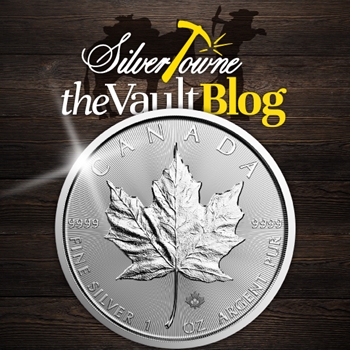
It is that time of year again where all the world bullion comes out with their 2020 designs! One of our most popular options? The Canadian Silver Maple Leaf!
In stock and available in a number of different increments, the 2020 Silver Canada Maple Leaf is produced in one Troy ounce of .9999 fine silver and has been highly sought after since its inception and initial production in 1988. This annually released legal tender coin depicts the current year date on the reverse as the effigy of Queen Elizabeth II is exhibited on the obverse. Backed by the Canadian Government, each silver piece has a face value of $5 (CAD).
Bullion DNA Anti-Counterfeiting Technology
Starting in 2018, Royal Canadian Mint bullion products have never been more secure. With every die micro-engraved with a laser featuring an anti-counterfeiting security mark in the form of a maple leaf on the obverse of the coin, this textured security marks allows for easy verification of a bullion product that has been registered through a secure database and approved by the Royal Mint themselves. Investors can then have the peace of mind knowing that authorized Bullion DNA dealers are selling them genuine and authentic product.
MINTSHIELD Surface Protection
In addition to Bullion DNA development, the Royal Canadian Mint tackled a solution for the reduction of white spots, or “milk spots”, on silver coins. Although the metal itself is in no way altered with the apparent white spots, the Mint focused on the concerns that many investors had with the overall appearance. After a four-year-long research and response process to find the root of the cause, each surface on each bullion coin has been ensured with the proprietary solution to visibly reduce the occurrence of white spots and are now protected with MINTSHIELD.
Royal Canadian Mint History
First operating as a branch of the Royal Mint in London, the Royal Canadian Mint was once referred to as the Ottawa branch in 1908 as Canada started emerging as a nation worth developing and producing coinage for. It was not until 1931 that the Ottawa Mint was renamed the Royal Canadian Mint after a negotiation for independence took place with the British Royal Mint during the Great Depression.
Operating as its own Canadian controlled entity, the Mint reported only to the Department of Finance and years later in 1969 was restructured as a Crown Corporation by the Canadian Government. This meant that it would operate with a Board of Directors that would be responsible for making its own decisions.
The original facility in Ottawa was designated a National Historic Site of Canada in 1979 and is now responsible for the production of collector and commemorative coins, bullion in the form of coins, bars, wafers and grains, medals, and medallions. The Mint’s refineries for both silver and gold are also located in Ottawa as well as the assay labs. Die creation for the actual striking of coins for both circulation and commemorative purposes are also done here.
The Royal Canadian Mint opened its facility in Winnipeg in 1976 as the Ottawa location was deemed at capacity. The Winnipeg location is responsible for the entirety of circulated coins as well as foreign coinage as it produces circulated coins for other nations including Cuba, Norway, Iceland, Thailand, and many more.











